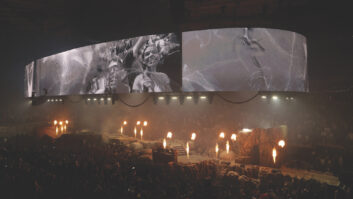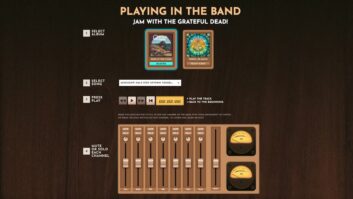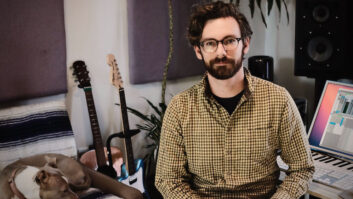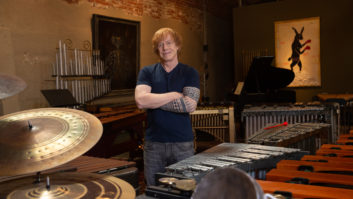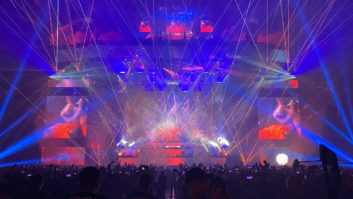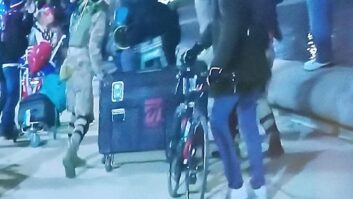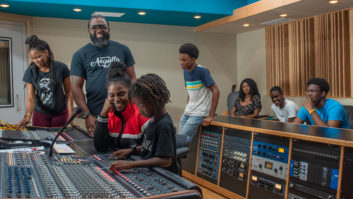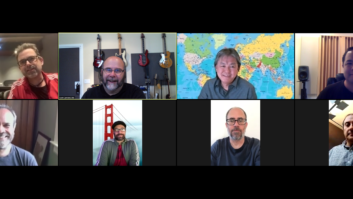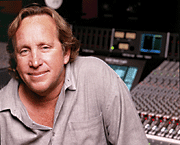

It’s about time surround recordings started getting a little respect — i.e., awards recognition. The medium has developed into a very special art form, and though there are many problems to be worked out (format, budgets, promotion), surround is here to stay. This is the first year that the Grammys and the TEC Awards have a category honoring surround production. We thought it would be fun to speak with the mixers from each of the five projects nominated for this year’s TEC Award. We should note, though, that the actual awards will be given to the mixer(s), mastering engineer, producer(s), mixing facility and mastering facility. That’s a lot of trophies — but well-deserved!
Ed Cherney mixed both versions of Nick of Time.
photo: Edward Colver
BONNIE RAITT: NICK OF TIME
Surround mix by Ed Cherney
Bonnie Raitt’s Grammy-winning album from 1989 was a natural choice to get the surround treatment, but Ed Cherney, who recorded and mixed the original, says, “At first, I really didn’t want to do it. I mean, I was glad that EMI called me to do it because you don’t always get to do the surround [mix] for albums you worked on. In this age of Pro Tools and everyone recording at home, I’m getting a lot of things that just aren’t that great to mix — there’s no dimensionality — but when I put up the multitrack [of Nick of Time] and played it, I really loved the way it filled the speakers, so I got real excited.” Cherney originally mixed the album on a Neve VR at the Record Plant; for the surround mix, he worked on the same kind of console, but at Capitol’s Studio C.

As is usually the case with surround albums that fans know and love, Cherney decided not to mess too much with success. “I wanted it to be like an extension of the original album,” he says. “There are no gimmicks or anything; no radical turns. It’s not effects-laden, with things panning across on a joystick. But there was a lot of room to spread it out, and I think it spread out in a very musical way that also makes sense.” Cherney says he put “some ambience, guitars and few other things” in the rear speakers, “but it wasn’t like I was sending things that discretely back there. It’s still fairly front-loaded, but with more depth in the room and more space around everything.”
Inevitably, the question of the center speaker arises. Cherney chuckles, and then remarks, “The center speaker is your friend. When I first started, the first few 5.1 [releases] I did, I was a little apprehensive about using the center speaker. That was after talking to Alan Parsons and some other people. But lately, I’ve been using it more and finding that it gives me a wider sweet spot. The vocal is good there, but I don’t want to leave the artist out there bare where you can isolate the vocal like that, so I’ve been building a mini-rhythm mix in the center speaker — it supports the vocal but isn’t loud enough that it takes away from the spread. There’s a preponderance of bass and kick drum and snare, maybe a rhythm guitar — it helps the groove.”
As for effects and ambience, he thus far has eschewed the popular multichannel units, noting, “I still build stereo pairs — front/left, front/right, left/rear, right/rear — and build an ambience that way. I’ll even build some ambience between right/front and right/surround. I’ve been using reverb more discretely than one send and five returns.”
Asked about Raitt’s reaction to the surround mix, Cherney reveals that, incredibly, the singer/guitarist had never heard a 5.1 mix before he sent a version to her at a San Francisco studio. “She didn’t really even like the idea: ‘It was great, why do we have to do it again?’ I said, ‘Well, it’s a new technology and it gives people a new context to hear your music. Trust me, I’m not going to mess with the intent,’” he says. “But that first time she heard it, she didn’t like it. I don’t know, maybe it wasn’t set up right. But she had some comments and I went back and did a few things, and the next time she heard it was at Capitol and it knocked her socks off. She immediately wanted to go in and do her whole catalog in 5.1!”

Fred Maher contemplates surround electronic music.
photo: Martin Stohl
CRYSTAL METHOD: LEGION OF BOOM
Surround mix by Fred Maher and Nathaniel Kunkel
Led by Ken Jordan and Scott Kirkland, Crystal Method have solid credentials in the rave/techno/electronic world, where they have been dancefloor favorites for a number of years. Legion of Boom is their third full-length album, and though it was self-produced and mixed, for the surround mix, they brought in Nathaniel Kunkel — who’s had great success mixing a number of decidedly more mainstream projects in past few years — and newcomer to 5.1 mixing Fred Maher, who ended up doing the bulk of the album. Maher, the one-time programmer for cult favorites Scritti Politti, as well as a drummer (for Lou Reed and others), producer (Matthew Sweet, Lloyd Cole, 10,000 Maniacs, et al.) and digital editor, says he’s “bounced a lot between electronic music and live performance” and managed to convince DTS — for whom he consults — and Crystal Method’s managers and label to let him work on a surround mix for the group. “I was really interested in getting some electronic music in surround; there’s not that much in the genre out there,” he says.

Maher says that Kunkel’s 5.1 mix of the duo’s single “Born Too Slow” provided the novice “with a jumping-off point. I learned a lot from hearing what he was doing. It was pretty challenging because with this kind of music, there’s no ‘proscenium’ — the instrumentation is more unconventional than that. It’s very wide open and a little tricky because they work with a lot of loops. There are almost no multitrack drums, so the core groove in some of their songs might comprise four or five loops layered on top of each other — some might be good-sounding stereo and others have kind of a crunchy mono vibe; there’s a lot to juggle.”
Maher did the bulk of his work at his L.A.-area home studio using a Nuendo system and JBL speakers as his primary tools. The first challenge was importing the band’s original Digital Performer tracks into Nuendo. “It was a nightmare,” he says. “They had sent me the Digital Performer sessions, but they had zillions of plug-ins and I couldn’t find an OS 9 TDM system with that version of Digital Performer. When they were on the road, I had to go over to their studio with somebody from their management company, and I spent about six days there just rendering tracks one by one.”
Once the materials were in order, Maher found plenty of room for creative mixing. And though he says he put lots of music in the rears and opted to have quite a bit of movement in the mix, “I found that once I got the core groove going, I tended to favor the front of the room anyway.” With Jordan and Kirkland on the road during much of the process, Maher made reference mixes to send to the musicians, “and they were trying to play them in hi-fi shops,” he says with a laugh. “Then I took my Nuendo rig over to the DTS mastering room [in Agoura Hills, Calif.] and I spent a few days with them, doing some tweaks and final touches. I think it came out really well.”

Al Schmitt won a Grammy for
Genius Loves Company.
RAY CHARLES: GENIUS LOVES COMPANY
Surround mix by Al Schmitt
Multi-Grammy — winning engineer Al Schmitt was a couple of weeks into mixing Ray Charles’ final album, Genius Loves Company, when Concord Records decided to spring for a 5.1 mix of the project. “That can make things a little more complicated,” Schmitt says during a break from mixing an Anita Baker Christmas album, one of five discs the in-demand engineer was working on in June. “What we do now is plan ahead and always make sure we have the configuration to do the surround without changing the board too much [from the stereo mix], because you don’t want to have to start from scratch if you suddenly have to do the surround. So we keep the extra buses open and so forth.”

Schmitt did the stereo and surround mixes in Capitol’s Studio C on the Neve VR, working exclusively with 96k Pro Tools sessions. “Since it was a duets album,” he comments, “what I did for the 5.1 was pan Ray between the left speaker and the center speaker so it sounds like he’s coming off-center, and then I took the other artist and panned them the opposite: the right going into the center. I also brought them forward a little bit so it sounds like they’re onstage next to one another. That helped a lot and gave us more room to work with other things in the mix.”
When it came to deciding on what to put in the rear speakers, Schmitt says, “When I first started doing surround mixes, I was very concerned about putting things in the back, so I’d put ambience back there; if it was a live thing, I’d put the audience back there. I still do that with live projects. But now I’m not as shy about putting other things in the back because people want to hear something there, so I’ll put percussion, or on a small date, like a Diana Krall record, I’ll put a guitar back there — mostly, but not discretely. I’ve had woodwinds back there and some orchestra.” On the Charles mix, however, his approach to the orchestra was, “If you put your arms straight out to your sides, it was that kind of spread — about 180 degrees. We also had some of the ambience mics we used during the sessions in the back.” Whatever he did, it obviously worked: Schmitt’s work on the album earned him another Grammy — the first in the new surround category.

Michael Brauer in his Quad Studios
SIMON & GARFUNKEL: OLD FRIENDS LIVE ON STAGE
Surround mix by Michael Brauer
In a fantastic quarter-century career that has seen him engineer and/or mix for the likes of Luther Vandross, Grace Jones, Aerosmith, Aretha Franklin, Rod Stewart, Pet Shop Boys, Bob Dylan, Paul McCartney, this season’s chartbusting smash by Coldplay and dozens more, New York — based Michael Brauer has worked in every pop and rock style imaginable. He’s also getting more calls to do surround mixes — his first was the Rolling Stones’ Steel Wheels IMAX video; projects for McCartney and others have followed.

“My approach is I want the listener to be in the money seats, like row 12 or row 13, dead-center,” Brauer says. “If you’re doing surround sound, you might as well be in the best seats, so I’ll have most of the audience behind, but you also want to feel the presence of the band in front of you and around you in the hall.”
In the case of the Simon & Garfunkel reunion CD/DVD project, the music cuts seamlessly between performances at Madison Square Garden (Manhattan) and the Continental Airlines Arena (New Jersey). “Kooster [McAllister of Record Plant Remote] recorded the shows and he did such a great job,” Brauer says. “There were a couple of songs where it cuts from one show to another and the levels totally matched. That made my job a lot easier.”
Brauer worked at his room at Quad Studios (New York City). To help create the ambience on the recordings, he used a Sony 777 DRE multichannel reverb. “In this particular application, I have a short hall feeding the front and a large hall feeding the back. I have this process that spreads things out a bit — I almost create this invisible middle wall so that you have the rear speakers and the front speakers, but then you have a seven and eight speaker to the left and right. You might start feeling like the guitar is really close to your ear on the left, but it feels like it’s outside the speaker. I send it through certain effects or short delays toward the back, and then I start bringing things up the front. It moves the front toward the side.”
Alone and together, Simon and Garfunkel showed up for a number of mix sessions and made suggestions, especially about the vocal blends. “I was mixing the stereo and the surround simultaneously,” Brauer says. “I’d start off in surround, get it feeling really good and then close it back down so I was just listening to my fold-down. When Paul and Artie would be in, I’d mix in stereo. Once they okayed the mix, I’d go back into the surround and see if there was anything else I needed there. A lot of the stuff that might be going into the back [of the surround mix], I might have that down 5 or 6 dB in the stereo mix, so I could do whatever I wanted in the back and it wouldn’t make the front too reverb-y or anything.”
ERIC CLAPTON & FRIENDS: CROSSROADS GUITAR FESTIVAL
Surround mix by Neil Dorfsman and Mick Guzauski
This multistage festival held in Texas in July of 2004 brought together blues, rock and jazz guitar giants — including host Eric Clapton, Buddy Guy, B.B. King, Jeff Beck, Pat Metheny, Steve Vai, Joe Walsh, James Taylor, Sonny Landreth, Neal Schon and many others — and a who’s who of top recording engineers, including the aforementioned Cherney, Maher and McAllister, plus David Hewitt, producer Simon Climie and recording team leader Elliot Scheiner.

The Crossroads festival
was mixed in stereo and surround.
Surround mixes were split by Mick Guzauski and Neil Dorfsman. Guzauski, who has mixed all of Clapton’s projects during the past few years, mixed his tracks (plus songs by Carlos Santana, King, J.J. Cale and a few others) at his Barking Doctor studio in Mt. Kisco, N.Y., while Dorfsman handled the other songs at the now-defunct Hit Factory in New York City.
The music was recorded into Nuendo (with 3348 backup); original audio sources ranged from material captured by the remote trucks to direct feeds from the P.A. consoles on the smaller stages. Guzauski imported the Nuendo files into Pro Tools and went through a Sony OXFR-3 board into another Pro Tools system for 5.1 and stereo mixing. “Usually I don’t do simultaneous 5.1 and stereo mixing,” he says, “but in this case, there was so much music and so little time to do it [about a week].” Guzauski watched videos of the event to reference venue size and stage setup. “Being outdoors,” he says, “there was very little ambience; you could hear some slap off some buildings, but it was pretty dry. That’s how it would sound outdoors, but you can’t have that in the final product. It has to sound like there’s a little excitement, something coming back at you, so I used some reverb and delays.”
Guzauski panned various sections of the audience across four speakers (left, right and surrounds) and used the center channel sparingly. “Center’s always a little bit confusing for me because I like a phantom center,” he says. “I use it to add a little bit of punch to kick, snare and bass, and focus the lead vocal. I don’t like to go too nuts with the center speaker because there are so many playback systems where the center channel is different, usually a little smaller than the left and right speaker. You don’t know what you’ll really get if you rely on the center speaker for much full-range information.”

Nathaniel Kunkel, TEC Nominee in the surround category for Crystal Method’s Legion of Boom, also recorded
David Crosby and Graham Nash’s latest, Crosby Nash
. Read about it (and check out lots of in-studio photos),
.
Crystal Method’s Ken Jordan and Scott Kirkland talk with Remix
magazine about the production techniques behind Legion of Boom.
to read the feature.
Read Blair Jackson’s feature on
recording Genius Loves Company
, mixed by Al Schmitt,
.
